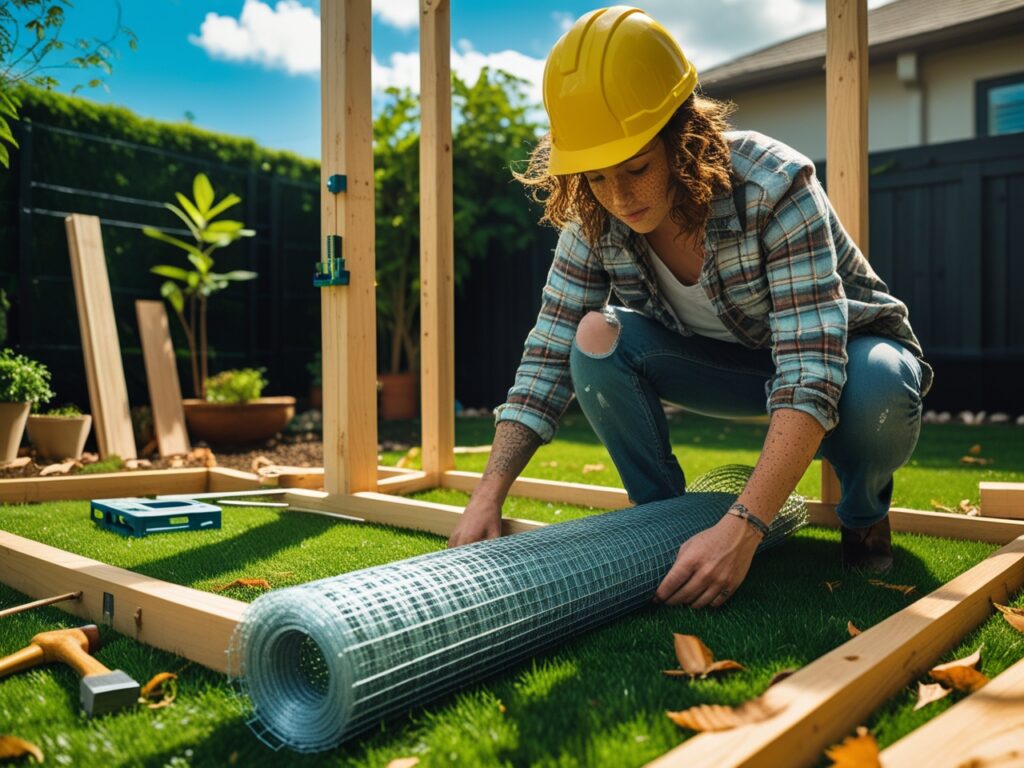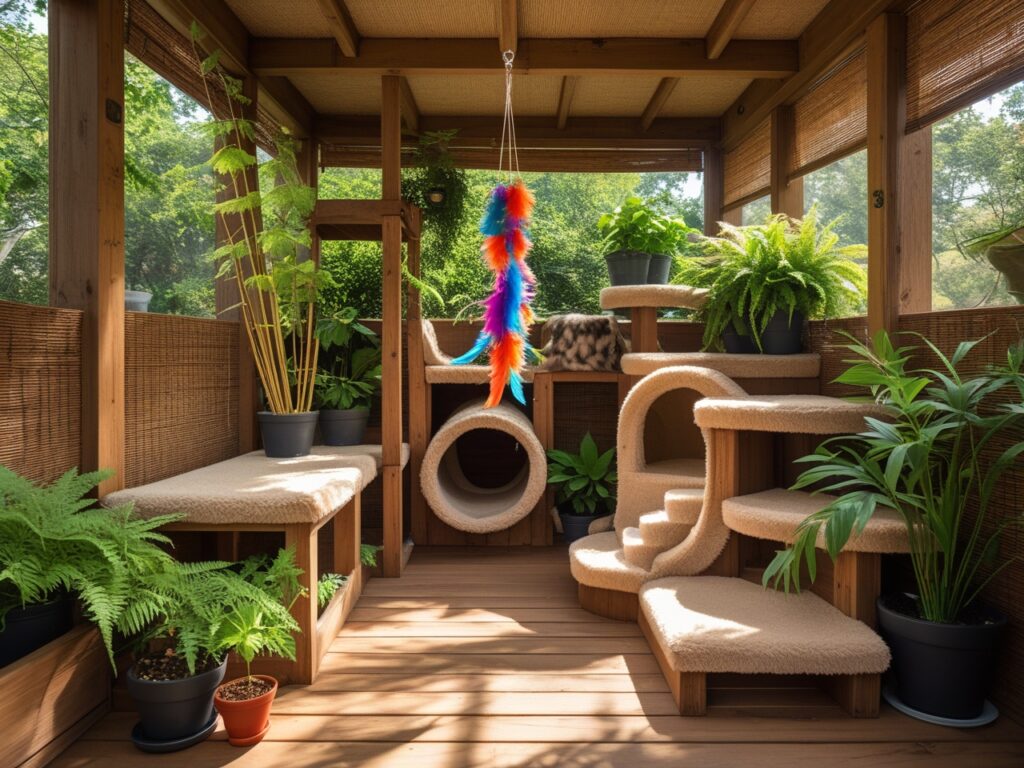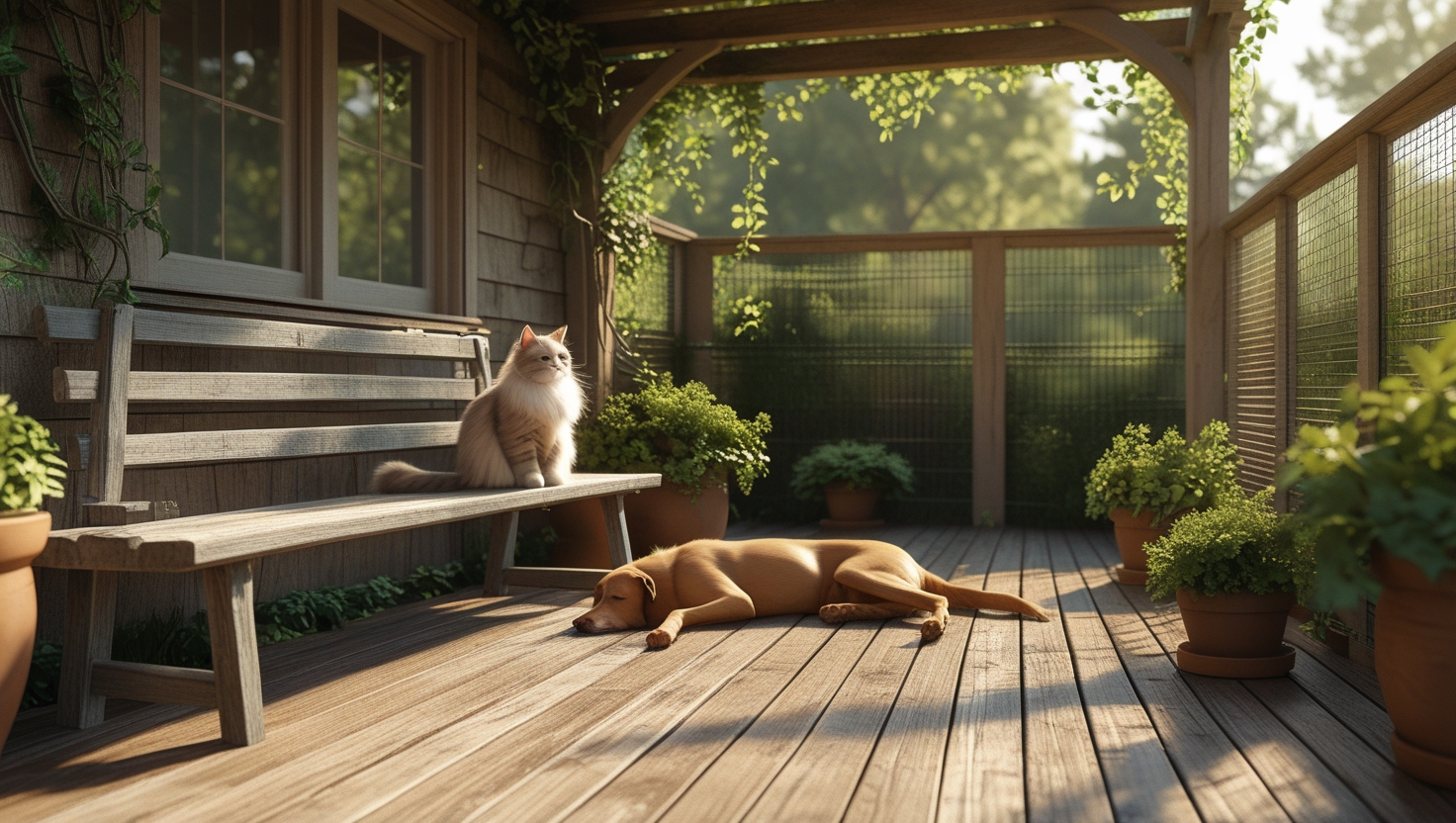Creating safe outdoor spaces—also known as a petio—does more than give your cat or dog fresh air. It can increase pet longevity, boost your home’s value, and protect neighborhood wildlife. This expert guide reveals how to build a secure, enriching, and affordable outdoor area your pets will love.
Why Safe Outdoor Spaces Matter: The Data & The Dangers
Letting pets roam freely outside comes with serious risks. According to the RSPCA, two out of three cat owners have lost a cat to a roaming-related accident. One in three cats dies in car accidents. Free-roaming dogs are at risk of fights, poisoning, or getting lost. These numbers highlight a growing concern among pet owners.
Safe outdoor spaces protect more than pets. The American Bird Conservancy reports that outdoor cats kill 2.4 billion birds annually in the U.S. Secure enclosures help reduce this impact.
Many pet injuries happen close to home—on patios, sidewalks, or driveways. Petios allow dogs and cats to enjoy the sights, smells, and sounds of the outdoors without exposure to predators, traffic, or toxins. Little-known fact: over 60% of cats lost outdoors are never recovered. Safe spaces change that.
From reduced injury risk to improved well-being, petios offer peace of mind and a better life for your four-legged family members.
Types of Outdoor Pet Enclosures: Comparing Catios, Dog Runs, and Hybrid Spaces
Not all petios are created equal. Understanding the different types will help you build the right space for your pet’s size, behavior, and needs.
Catios—Not Just for Cats
A catio is a fully or partially enclosed area that lets your cat experience the outdoors safely. These can range from compact window boxes to full patio conversions. Most use escape-proof mesh, shelves for climbing, and weatherproof roofing. Some owners install tunnels connecting the catio to indoor windows.
While designed for cats, catios also suit rabbits, guinea pigs, and even small dogs. Their modularity and ease of customization make them a top choice for multi-pet households. A little-known bonus: cats in catios show reduced signs of boredom, including less scratching and meowing.
Dog Runs—From Simple to High-Tech
Dog runs offer enclosed exercise areas tailored to a dog’s size and energy. Some are basic fenced corridors, while others feature turf flooring, play structures, and even smart pet doors. Durable fencing is key—galvanized steel or heavy-duty mesh works best.
These enclosures allow dogs to play safely while preventing digging, escaping, or neighborhood disruptions. Many owners report a drop in barking complaints after installing a dedicated outdoor space. A good dog run balances containment with stimulation.
Hybrid Spaces for Multi-Pet Households
Hybrid petios allow cats and dogs to share space while keeping species-specific needs in mind. Vertical zones with shelves give cats safe vantage points, while dogs enjoy floor-level features like digging pits.
In Austin, Texas, one family created a shared enclosure with a raised cat walkway and a shaded dog lounge. With proper design, cats and dogs coexist peacefully. Hybrid setups are ideal for families with varied pets and limited space.
Planning Your Petio: Site Selection, Safety, and Design
Good planning ensures your petio is safe, functional, and enjoyable. Start by evaluating your outdoor space. Look for spots that offer partial shade, moderate airflow, and minimal foot traffic. Avoid placing the petio near busy roads or shared property lines.
Sun and wind exposure affect comfort and safety. Orienting the petio to the east can provide morning sun while protecting pets from harsh afternoon heat. Little-known fact: the orientation of your petio can improve your home’s energy efficiency by shading windows and reducing indoor temperatures.
Safety should be top priority. Use this checklist:
- Ensure fencing is at least 6 feet tall (for dogs).
- Use claw-resistant mesh (for cats).
- Anchor structures to resist wind.
- Avoid toxic plants and sharp edges.
- Include escape-proof latches on doors.
Finally, consider drainage and weather protection. Elevated bases or gravel floors prevent puddles. Add awnings or partial roofs to protect from rain or snow.
Smart design today means less worry tomorrow.
Building Materials and Construction: What the Pros Use
The right materials make the difference between a short-term fix and a long-lasting solution. Choose products that are safe, durable, and suited to your climate.
Mesh, Screens, and Fencing—What Really Works
Galvanized steel mesh is a top choice. It resists rust, holds shape, and survives clawing. Avoid plastic mesh, which breaks down in sunlight and can be chewed through. Aluminum screens offer a balance of weight and strength.

Some specialty mesh types can block up to 80% of UV rays—helping prevent sunburns and skin cancer in light-colored pets. These also keep your pet cool and reduce glare. For large dogs, chain-link fencing remains a strong and affordable choice.
Flooring and Roofing—Comfort and Longevity
Choose flooring that’s soft on paws and easy to clean. Artificial turf offers a clean look with little upkeep. Pea gravel allows for natural drainage. Wood decking works well if sealed and sanded smooth.
Roofing options include metal panels, polycarbonate sheets, or weather-resistant fabric. For added insulation, consider a green roof or living wall. These features don’t just look good—they help cool the space and attract pollinators, turning your petio into a tiny ecosystem.
Mix comfort with utility, and your pets will love every inch of their outdoor retreat.
Enrichment & Wellness: Making Outdoor Time Safe and Stimulating
A safe space isn’t enough—pets need stimulation too. Enrichment features keep them physically active and mentally engaged.
Cats benefit from climbing platforms, hideouts, and high ledges. Tunnels and shelves provide adventure and vertical territory. Dogs thrive with scent stations, digging areas, and toys they can interact with.

Include sensory elements like water bowls with bubblers or wind chimes. Even a patch of cat-safe grass or dog-friendly herbs like rosemary or mint adds value. These plants can reduce stress and improve digestion.
One pet owner added hiding tubes, puzzle feeders, and a rotating scent log to their catio. Within weeks, their once-destructive indoor cat showed a 70% reduction in scratching furniture.
The more your pet can explore, the more they’ll enjoy being outside.
Real-World Success Stories & Case Studies
Urban Apartment Catio
In Brooklyn, a couple added a catio to their 6th-floor balcony using clear panels, mesh, and shelving. Their indoor-only cat now enjoys fresh air and people-watching from a secure spot. The space doubled as a green nook with hanging plants.
Suburban Dog Run
In Denver, a family turned a side yard into a dog run using recycled lumber and turf. They added a dig box, water fountain, and a shade sail. Their retriever spends hours outside daily, reducing destructive chewing indoors.
Rural Hybrid Enclosure
A couple in Oregon built a shared enclosure using welded wire panels and raised wooden platforms. Cats roamed above while their dog lounged below. The setup cost under $1,200 and survived multiple winters with no major maintenance.
Each project improved pet behavior, owner satisfaction, and even added resale value.
Market Trends & Performance Data: What’s Hot in 2025
The safe outdoor living spaces structure market hit $2.32 billion in 2024 and is projected to reach $3.35 billion by 2030. Much of this growth comes from pet-friendly builds and backyard upgrades.
The U.S. deck and patio construction market reached $1.1 billion in 2025. Pergolas and screened patios account for 64% of that, as families prioritize outdoor comfort for both people and pets.
Modular, eco-friendly enclosures are trending. Think solar shades, plug-in misting fans, and rain-collection systems. Lightweight kits with expandable panels are especially popular among renters and small-space dwellers.
Adding a petio also boosts property value. Real estate agents report improved buyer interest in homes with well-built enclosures, especially in pet-loving cities.
Customer Voices: Reviews, Testimonials, and Lessons Learned
On YouTube, pet parents rave about the peace of mind that petios offer. One owner described five years without a single predator incident in a coyote-heavy area, thanks to secure framing and heavy mesh.
Reddit users love prefab kits for their ease of assembly. However, many recommend reinforcing lightweight models with wood or steel for better durability. Customization is common—pet tunnels, elevated sunbathing zones, and grass patches are among the most popular upgrades.
One user built a modular catio on a deck, only to realize the mesh didn’t hold up to snow. Lesson learned: choose materials based on local weather.
Another upgraded from chicken wire to galvanized mesh after their cat escaped. A locking latch and double-door system fixed the issue for good.
First-hand insights help future builders avoid common mistakes and get it right the first time.
Expert Tips for Building a Petio That Lasts
Longevity starts with smart planning and smart materials. Experts recommend investing in quality mesh and roofing up front, rather than facing repairs every season.
Apply rust-proof sealant on metal parts and stain wooden surfaces yearly. Check for wear after storms and replace warped boards or sagging netting promptly.
Build these safe outdoor spaces with your pet’s future in mind. Add ramps and low platforms for aging pets. Leave room to expand if your pet family grows. Install flexible components that can be relocated or upgraded later.
Shade is crucial. A UV canopy or solid roof keeps pets comfortable and prevents overheating. For colder climates, add insulation or removable weather panels to block drafts.
A good petio grows with your family—and your pets’ needs.
Frequently Asked Questions
Yes. Modular enclosures with minimal anchoring work well for renters and are easy to disassemble.
With weatherproof materials and covered zones, yes. Add insulation and warm bedding for comfort.
Most small enclosures do not. However, check HOA rules or city codes, especially for permanent structures.
10–15 years with quality materials and seasonal maintenance.
Absolutely. With smart layout and supervision, cats, dogs, and even rabbits can enjoy shared outdoor zones.
Conclusion & Next Steps
Safe outdoor spaces give pets freedom, enrichment, and security. With the right planning and materials, you can create a petio that fits your space, your budget, and your lifestyle.
Ready to get started? Download our free Petio Safety Checklist and give your pet the backyard they deserve.
